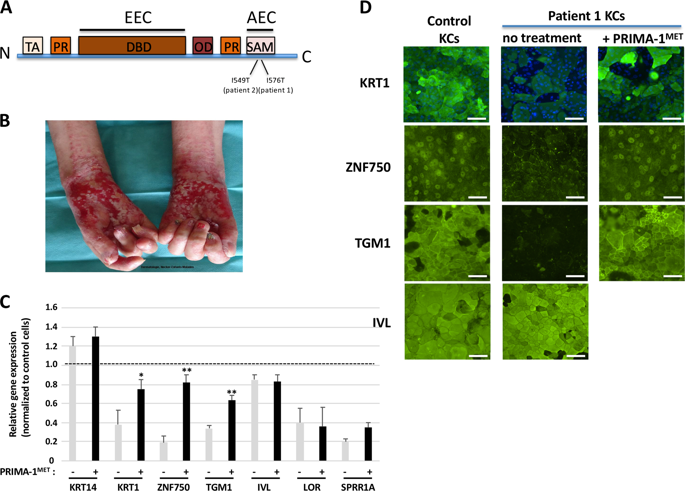当前位置:
X-MOL 学术
›
Cell Death Dis.
›
论文详情
Our official English website, www.x-mol.net, welcomes your
feedback! (Note: you will need to create a separate account there.)
Improvement of epidermal covering on AEC patients with severe skin erosions by PRIMA-1MET/APR-246.
Cell Death & Disease ( IF 8.1 ) Pub Date : 2020-01-16 , DOI: 10.1038/s41419-020-2223-8 Edith Aberdam 1, 2 , Lauriane N Roux 1, 2 , Philippe-Henri Secrétan 3, 4 , Franck Boralevi 5 , Joël Schlatter 3 , Fanny Morice-Picard 5 , Stefano Sol 6, 7 , Christine Bodemer 8, 9, 10 , Caterina Missero 6, 7 , Salvatore Cisternino 3, 11 , Daniel Aberdam 1, 2 , Smail Hadj-Rabia 8, 9, 10
Cell Death & Disease ( IF 8.1 ) Pub Date : 2020-01-16 , DOI: 10.1038/s41419-020-2223-8 Edith Aberdam 1, 2 , Lauriane N Roux 1, 2 , Philippe-Henri Secrétan 3, 4 , Franck Boralevi 5 , Joël Schlatter 3 , Fanny Morice-Picard 5 , Stefano Sol 6, 7 , Christine Bodemer 8, 9, 10 , Caterina Missero 6, 7 , Salvatore Cisternino 3, 11 , Daniel Aberdam 1, 2 , Smail Hadj-Rabia 8, 9, 10
Affiliation

|
P63 is a major transcription factor regulating skin development and homeostasis. It controls many genes involved in cell proliferation, adhesion, and early differentiation. P63 is mutated in several rare syndromes called p63-related ectodermal dysplasia syndromes (ED). The main forms are EEC and AEC syndromes due to p63 missense mutations on the DBD and SAM domains, respectively. ED patients display many developmental defects, including ectrodactyly, clef/lip palate, and ectodermal dysplasia, while AEC patients suffer from severe skin erosions that not always heal. We have previously showed that ED-derived iPSC display altered epidermal commitment. P63 belongs to the p53 gene family sharing similar structural domains. We found that ED-iPSC epidermal commitment can be rescued by a p53-reactivating compounds called PRIMA-1MET, also named APR-246 and currently used in anticancer clinical trials. Here, we established primary epidermal culture from two AEC children (S.F. and Y.M.) suffering from persistent skin erosions at age of 9 and 15, respectively. These patients carry missense mutations on the SAM domain (I576T and I537T). We found that primary keratinocytes (KCs) isolated from these AEC patients underwent altered epidermal differentiation that was rescued by PRIMA-1MET treatment. It prompted us to formulate the compound onto a cream that was topically applied on the right hand of one patient and on the scalp of the second patient. In both cases, the daily treatment allowed re-epithelialization of the eroded skin and a drastic loss of pain after few weeks, improving quality of life. Normally, mutant p63 exerts a dominant-negative effect, mainly through the formation of aggregate with WT p63 and p73. PRIMA-1MET did not reduce protein aggregation while enhancing cell differentiation, suggesting that PRIMA-1MET targets cell differentiation and not p63 activity directly. In conclusion, we propose that repurposing of the antitumoral PRIMA-1MET compound could become a general treatment of AEC skin erosions.
中文翻译:

PRIMA-1MET/APR-246 改善严重皮肤糜烂 AEC 患者的表皮覆盖。
P63 是调节皮肤发育和体内平衡的主要转录因子。它控制着许多参与细胞增殖、粘附和早期分化的基因。P63 在几种称为 p63 相关外胚层发育不良综合征 (ED) 的罕见综合征中发生突变。主要形式是 EEC 和 AEC 综合征,分别是由于 DBD 和 SAM 结构域上的 p63 错义突变。ED 患者表现出许多发育缺陷,包括外指、谱号/唇腭和外胚层发育不良,而 AEC 患者患有严重的皮肤糜烂,并不总是愈合。我们之前已经表明 ED 衍生的 iPSC 显示出改变的表皮承诺。P63 属于共享相似结构域的 p53 基因家族。我们发现 ED-iPSC 表皮承诺可以被称为 PRIMA-1MET 的 p53 再激活化合物拯救,也命名为 APR-246,目前用于抗癌临床试验。在这里,我们建立了两个 AEC 儿童(SF 和 YM)的原代表皮培养物,这些儿童分别在 9 岁和 15 岁患有持续性皮肤糜烂。这些患者在 SAM 结构域(I576T 和 I537T)上携带错义突变。我们发现从这些 AEC 患者中分离出的原代角质形成细胞 (KCs) 经历了改变的表皮分化,这些分化被 PRIMA-1MET 治疗挽救了。它促使我们将这种化合物配制在一种乳膏上,该乳膏局部涂抹在一名患者的右手和第二名患者的头皮上。在这两种情况下,每天的治疗使受侵蚀的皮肤重新上皮化,几周后疼痛急剧减轻,提高了生活质量。通常,突变体 p63 发挥显性负作用,主要通过与 WT p63 和 p73 形成聚集体。PRIMA-1MET 在增强细胞分化的同时没有减少蛋白质聚集,这表明 PRIMA-1MET 直接靶向细胞分化而不是 p63 活性。总之,我们建议重新利用抗肿瘤 PRIMA-1MET 化合物可以成为 AEC 皮肤侵蚀的一般治疗方法。
更新日期:2020-01-16
中文翻译:

PRIMA-1MET/APR-246 改善严重皮肤糜烂 AEC 患者的表皮覆盖。
P63 是调节皮肤发育和体内平衡的主要转录因子。它控制着许多参与细胞增殖、粘附和早期分化的基因。P63 在几种称为 p63 相关外胚层发育不良综合征 (ED) 的罕见综合征中发生突变。主要形式是 EEC 和 AEC 综合征,分别是由于 DBD 和 SAM 结构域上的 p63 错义突变。ED 患者表现出许多发育缺陷,包括外指、谱号/唇腭和外胚层发育不良,而 AEC 患者患有严重的皮肤糜烂,并不总是愈合。我们之前已经表明 ED 衍生的 iPSC 显示出改变的表皮承诺。P63 属于共享相似结构域的 p53 基因家族。我们发现 ED-iPSC 表皮承诺可以被称为 PRIMA-1MET 的 p53 再激活化合物拯救,也命名为 APR-246,目前用于抗癌临床试验。在这里,我们建立了两个 AEC 儿童(SF 和 YM)的原代表皮培养物,这些儿童分别在 9 岁和 15 岁患有持续性皮肤糜烂。这些患者在 SAM 结构域(I576T 和 I537T)上携带错义突变。我们发现从这些 AEC 患者中分离出的原代角质形成细胞 (KCs) 经历了改变的表皮分化,这些分化被 PRIMA-1MET 治疗挽救了。它促使我们将这种化合物配制在一种乳膏上,该乳膏局部涂抹在一名患者的右手和第二名患者的头皮上。在这两种情况下,每天的治疗使受侵蚀的皮肤重新上皮化,几周后疼痛急剧减轻,提高了生活质量。通常,突变体 p63 发挥显性负作用,主要通过与 WT p63 和 p73 形成聚集体。PRIMA-1MET 在增强细胞分化的同时没有减少蛋白质聚集,这表明 PRIMA-1MET 直接靶向细胞分化而不是 p63 活性。总之,我们建议重新利用抗肿瘤 PRIMA-1MET 化合物可以成为 AEC 皮肤侵蚀的一般治疗方法。











































 京公网安备 11010802027423号
京公网安备 11010802027423号